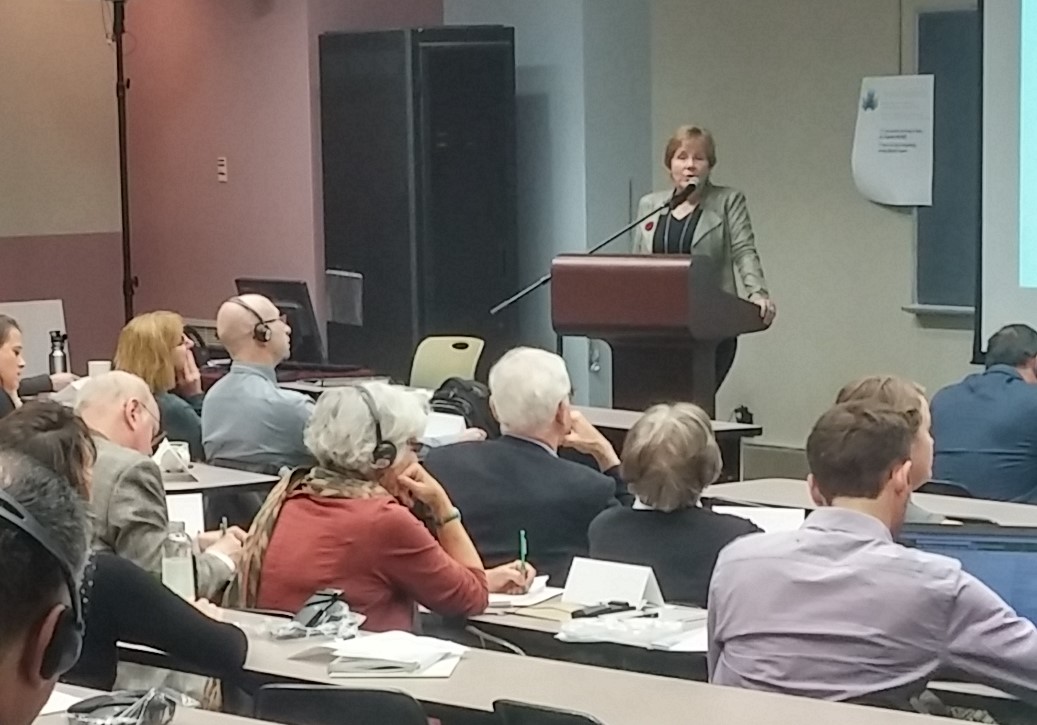
MUSE: A pan-Canadian project promoting health equity through built environments

Scientific director of the NCCDH, Connie Clement (seated, in orange), takes in a presentation by Lise Gauvin of the Department of Social and Preventive Medicine, École de santé publique, Université de Montréal (Photo: Don Goodes)
The National Collaborating Centre for Determinants of Health (NCCDH) is partnering in an exciting and ambitious collaboration between public health research and practice leaders. This five-year initiative is called Multisectoral Urban Systems for Health and Equity in Canadian Cities — or MUSE, for short.
This multifaceted, pan-Canadian project will study how municipalities, public health and community organizations work together to design our cities in ways that improve access to health-enhancing opportunities and, ultimately, to fairer distribution of health outcomes.
Purpose of the collaboration
During its five-year tenure, MUSE partners will participate in coordinated studies that explore the positive impact that intersectoral working relationships have had on population health and health equity. The research program will focus on how building effective intersectoral partnerships can transform built environments to improve access to affordable food and housing, outlets for physical activity and the availability of walkable and cyclable neighbourhoods. (For more information on this topic, we welcome you to attend our December 11, 2017, webinar on the impact that built environments have on the mental health of children and youth.)
Core to the research aim is learning about the extent to which the chosen intersectoral collaborations reduce health inequities, as well as how this is done. The scope may include, for instance, health in relation to income, race, neighbourhood and educational attainment.
A meeting of minds
On November 8, 2017, I had the pleasure of joining the more than 50 ndividuals from across Canada who took part in MUSE’s first “collaboratory” gathering. (Collaboratory, a new word to me, was coined by combining collaboration and laboratory.)
The team of MUSE investigators includes multiple skilled practitioners who have had close ties to the NCCDH over the years. One of the three principal co-investigators, Dr. Marie-France Raynault (Léa-Roback Research Center on Social Inequalities in Health), has been on the NCCDH advisory board for the past six years, stepping down this month. A second principal investigator, Dr. Nazeem Muhajarine (Saskatchewan Population Health Evaluation Research Unit, University of Saskatchewan), sits on the NCCDH evaluation reference group. And Louise Potvin (Institute of Public Health Research, Université de Montréal), a founding NCCDH advisory board member, will co-lead one of the initiative’s five projects.
The primary partners are the public health officers from Vancouver, Saskatoon, Toronto and Montreal. Even more impressive, one of the key research projects will involve public health leaders from 24 of Canada’s large and medium-sized cities.
The NCCDH’s role
The NCCDH will help the principal researchers and participating city leaders deepen the integration of equity concepts in the following areas:
- research methods
- the selection of promising intersectoral partnerships
- the analyses and the translation of findings
The NCCDH — along with the National Collaborating Centre for Healthy Public Policy — will support the MUSE team’s commitment to share learnings along the way with a range of audiences in accessible language and formats.
As a verb, muse means to contemplate thoughtfully. The NCCDH looks forward to intentionally musing in partnership with this team of dedicated researchers and practitioners. I am excited to to discoveries that will be dear to the heart of the NCCDH’s mission — the kind of “how-to” information that you, our users, are hungry to acquire.
For more information about the launch of the project, click here.
To be notified when the MUSE website is formally launched, click here.
To learn more about intersectoral collaboration, click here.
